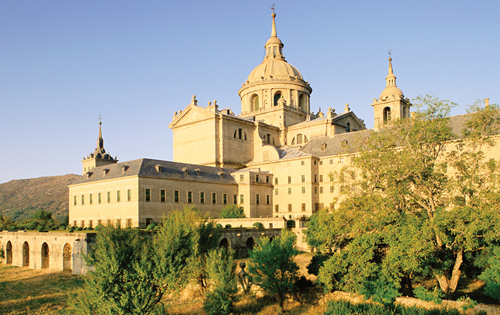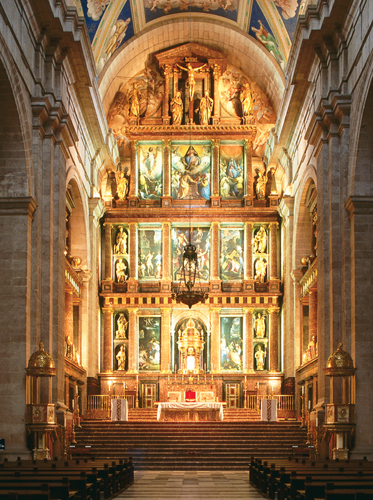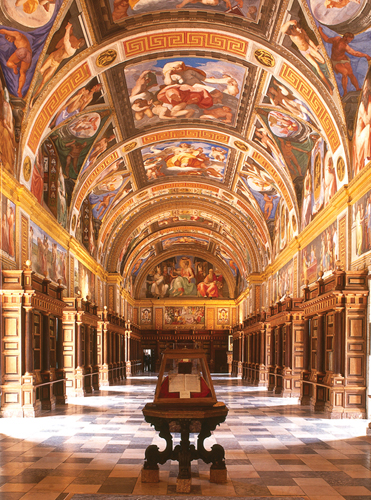Enjoying a suitably majestic setting in the southern
foothills of the Sierra de Guadarrama, the Royal Monastery of San
Lorenzo de El Escorial was commissioned by Felipe II as a mausoleum for
the tomb of his father, Carlos I. The name commemorates the victory over
the French at St Quentin on the Feast of St Laurence, in 1557. Building
began in 1563 and, from the outset, the king took a keen interest in
the smallest details of the project, even down to the choice of site.
The complex was finally completed in 1595 and comprised a basilica, a
royal palace, a monastery, a seminary and a library. This stupendous
granite monument to the king’s personal aspirations and to the ideals of
the Catholic Counter Reformation still inspires awe, if not always
affection.
San Lorenzo del Escorial Train from Atocha or Chamartín, then bus from the station 91 890 5904
www.patrimonionacional.es
Open Apr–Sep: 10am–6pm Tue–Sun;
Oct–Mar: 10am–5pm Tue–Sun; Closed Mon, 1 Jan, 6 Jan, 1 May, 10 Aug, 9
Sep, 24 Dec, 25 Dec, 31 Dec Adm €8 (except Wed for EU citizens), €10 (for a guided tour)
|
|
Before architect Juán
Bautista de Toledo was allowed to embark on El Escorial, Felipe gave him
precise instructions. He should aim for “simplicity in the
construction, severity in the whole, nobility without arrogance, majesty
without ostentation.” When Toledo died in 1577, his successor, Juan de
Herrera, followed Felipe’s precepts. The design was intended to resemble
the iron grid on which St Laurence was roasted alive.
|

Plan of El Escorial

View of El Escorial
|
San Lorenzo del Escorial has a good selection of bars and restaurants.
|
|
|
To escape the worst of the queues, arrive before midday and avoid Wednesdays, when admission to the palace is free.
|
|
Top 10 FeaturesBasílica The basílica takes the form of a Greek cross, with vaults decorated with frescoes by Luca Giordano.

King’s Apartments Felipe
II’s personal quarters appear surprisingly modest – just three simply
furnished rooms with whitewashed walls and terracotta tiling. Look out
for the hand chair used to carry the gout-ridden king on his last
journey here in 1598. Pantheon of the Kings Work
on the domed burial chamber directly under the high altar of the
basílica, was completed in 1654. The walls were surfaced with marble,
bronze and jasper by Giovanni Battista Crescenzi. Chapter Houses The
vaulted ceilings were decorated in the 17th century by Italian artists
Fabrizio Castello and Nicola Granelo. Hanging from the walls are
priceless canvases by Titian, Tintoretto, Veronese, Velázquez and El
Greco. Library The
magnificent barrel vaulted hall has stunning ceiling frescoes by
Italian artists. The shelves contain 4,000 precious manuscripts and
40,000 folio volumes arranged facing outwards to allow air to permeate
the pages.

Gallery of Battles Recently
restored, this gallery is decorated with superb frescoes by
16th-century Italian artists. The paintings were intended to validate
Felipe II’s military campaigns. Main Staircase Look up from this magnificent staircase to admire the “Glory of the Spanish monarchy” frescoes by Luca Giordano. Strolling Gallery Felipe II enjoyed indoor walks in this airy gallery. The meridians on the floor were added in the 18th century. Courtyard of the Kings This
courtyard offers the best view of the basílica façade, its twin
belltowers and aweinspiring dome. The larger than life statues of Old
Testament kings over the portal give the courtyard its name. Architecture Museum This
small exhibition of plans, scale models and workmen’s tools explains
how El Escorial was constructed. Note the wooden cranes and hoists used
to haul the blocks of granite into place.
|